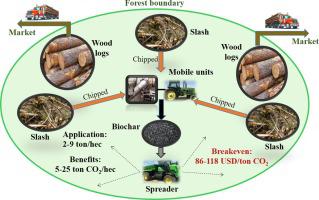当前位置:
X-MOL 学术
›
Energy Convers. Manag.
›
论文详情
Our official English website, www.x-mol.net, welcomes your
feedback! (Note: you will need to create a separate account there.)
Technoeconomic and emissions evaluation of mobile in-woods biochar production
Energy Conversion and Management ( IF 9.9 ) Pub Date : 2020-11-01 , DOI: 10.1016/j.enconman.2020.113305 Sonal K. Thengane , Kevin Kung , Robert York , Shahabaddine Sokhansanj , C. Jim Lim , Daniel L. Sanchez
Energy Conversion and Management ( IF 9.9 ) Pub Date : 2020-11-01 , DOI: 10.1016/j.enconman.2020.113305 Sonal K. Thengane , Kevin Kung , Robert York , Shahabaddine Sokhansanj , C. Jim Lim , Daniel L. Sanchez

|
Abstract In-woods torrefaction of forest residues to produce biochar can sequester CO2 in long-lived products at potentially lower-cost and complexity than centralized biochar production. Yet there are major uncertainties around operations, cost, and emissions associated with in-woods processing. We present a technoeconomic and emissions analysis for mobile in-woods biochar production systems employing oxidative torrefaction, associated with a timber harvest in Jackson Demonstration State Forest (JDSF) of California as case study. Most of the processing site area is required for the pile of grinded slash feed and drying operations. Breakeven production costs for transport, processing, and application together range between 567 and 573 USD/ton biochar-C (equivalent to 392–341 USD/ton biochar). The dryer, if employed, and the reactor constitute the major portion of capital costs. Labor constitute the largest portion of operating costs, followed by tub grinder rental and biochar application within the forest soil. The requirement of a separate dryer can be relaxed for a mobile in-woods facility, as oxidative torrefaction provides the opportunity to process feedstock with relatively high moisture content (~50%). The respective net GHG emissions for two systems with and without dryer are 5.43 and 7.94 ton CO2 eq/ton biochar-C. However, when the emissions from natural decay of slash (if left unprocessed) are accounted as avoided emissions, the systems with and without dryer result in the respective GHG emission benefits of 6.61 and 4.85 ton CO2 eq/ton biochar-C. The systems reach their break-even point when CO2 emission benefits are valued at a minimum of 85.7–118.1 USD/ton CO2.
中文翻译:

移动式林内生物炭生产的技术经济和排放评价
摘要 森林残留物的林内烘烤以生产生物炭可以以比集中生产生物炭更低的成本和复杂性来隔离长寿命产品中的二氧化碳。然而,在与林内加工相关的操作、成本和排放方面存在重大不确定性。我们提出了采用氧化烘焙的移动式林内生物炭生产系统的技术经济和排放分析,与加利福尼亚州杰克逊示范森林 (JDSF) 的木材采伐相关,作为案例研究。大部分加工场地区域用于堆积研磨斜线进料和干燥操作。运输、加工和应用的盈亏平衡生产成本在 567 至 573 美元/吨 biochar-C 之间(相当于 392-341 美元/吨 biochar)。烘干机,如果使用,和反应堆构成资本成本的主要部分。劳动力占运营成本的最大部分,其次是桶磨机租赁和森林土壤中的生物炭应用。对于移动式林内设施,可以放宽对单独干燥器的要求,因为氧化烘焙提供了处理水分含量相对较高(~50%)的原料的机会。带和不带干燥器的两个系统各自的净温室气体排放量分别为 5.43 和 7.94 吨二氧化碳当量/吨生物炭-C。然而,如果将斜线自然腐烂(如果未进行处理)的排放算作避免排放,则配备和不配备干燥器的系统各自的温室气体排放效益分别为 6.61 和 4.85 吨二氧化碳当量/吨生物炭-C。当 CO2 排放收益的估值至少为 85.7-118 时,系统就会达到盈亏平衡点。
更新日期:2020-11-01
中文翻译:

移动式林内生物炭生产的技术经济和排放评价
摘要 森林残留物的林内烘烤以生产生物炭可以以比集中生产生物炭更低的成本和复杂性来隔离长寿命产品中的二氧化碳。然而,在与林内加工相关的操作、成本和排放方面存在重大不确定性。我们提出了采用氧化烘焙的移动式林内生物炭生产系统的技术经济和排放分析,与加利福尼亚州杰克逊示范森林 (JDSF) 的木材采伐相关,作为案例研究。大部分加工场地区域用于堆积研磨斜线进料和干燥操作。运输、加工和应用的盈亏平衡生产成本在 567 至 573 美元/吨 biochar-C 之间(相当于 392-341 美元/吨 biochar)。烘干机,如果使用,和反应堆构成资本成本的主要部分。劳动力占运营成本的最大部分,其次是桶磨机租赁和森林土壤中的生物炭应用。对于移动式林内设施,可以放宽对单独干燥器的要求,因为氧化烘焙提供了处理水分含量相对较高(~50%)的原料的机会。带和不带干燥器的两个系统各自的净温室气体排放量分别为 5.43 和 7.94 吨二氧化碳当量/吨生物炭-C。然而,如果将斜线自然腐烂(如果未进行处理)的排放算作避免排放,则配备和不配备干燥器的系统各自的温室气体排放效益分别为 6.61 和 4.85 吨二氧化碳当量/吨生物炭-C。当 CO2 排放收益的估值至少为 85.7-118 时,系统就会达到盈亏平衡点。











































 京公网安备 11010802027423号
京公网安备 11010802027423号